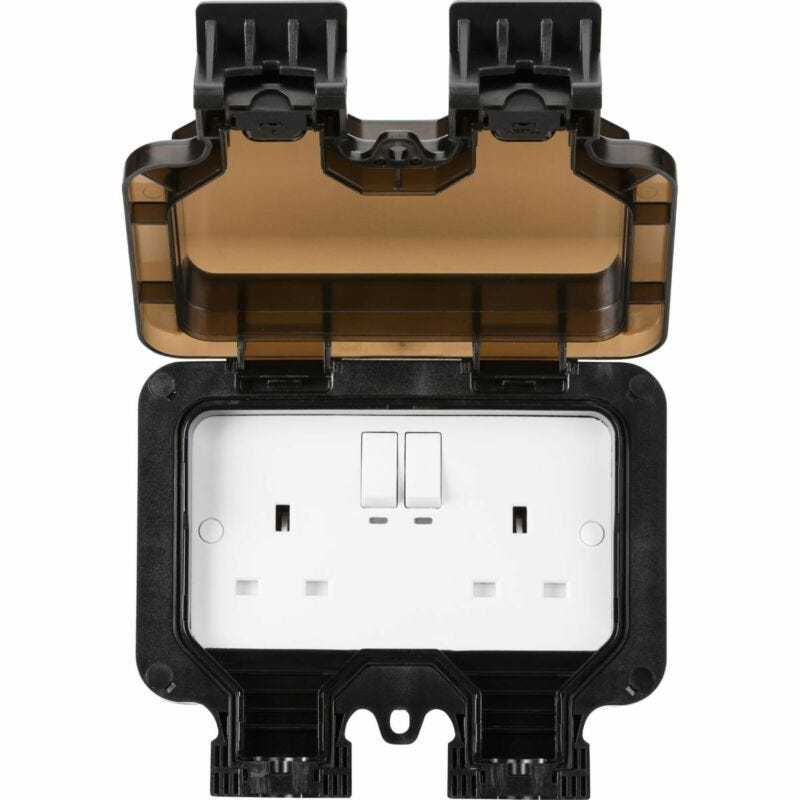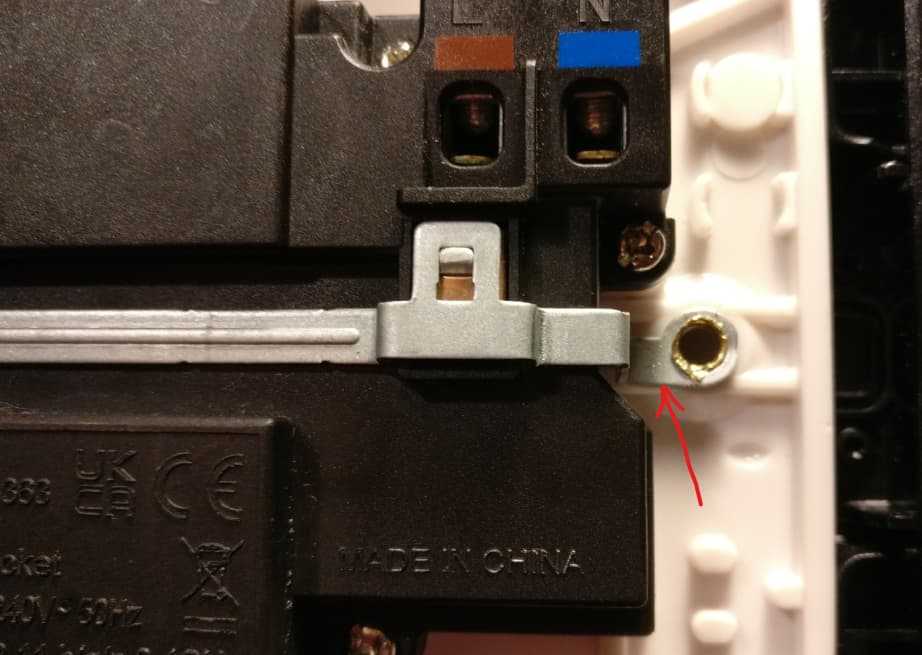devices.esphome.io
Knightsbridge CU9KW Smart Wall Socket
Knightsbridge CU9KW Smart Wall Socket
Device Type: plugElectrical Standard: ukBoard: esp8266Difficulty: Soldering required, 4/5
General Notes
The Knightsbridge CU9KW is a UK-format smart wall socket that lets you switch two outlets on/off remotely and monitors real-time power usage and cumulative energy consumption over Wi-Fi. It fits a standard 2-gang back box and supports OTA updates via ESPHome.
The Knightsbridge OP9KW is the exact same product, with the outdoor case, so instructions will work exactly the same for both.
Manufacturer: Knightsbridge (ML Accessories)


GPIO Pinout
| Pin | Function |
|---|---|
| GPIO15 | Relay output for Outlet 1 |
| GPIO4 | Relay output for Outlet 2 |
| GPIO2 | LED indicator for Outlet 1 (inverted) |
| GPIO0 | LED indicator for Outlet 2 (inverted) |
| GPIO16 | Push-button for Outlet 1 |
| GPIO13 | Push-button for Outlet 2 |
| GPIO12 | HLW8012 SEL pin (power/energy selector) |
| GPIO5 | HLW8012 CF pin (power pulse) |
| GPIO14 | HLW8012 CF1 pin (voltage pulse) |
Flashing
Based on the procedure shared by maxwroc in the Home Assistant community forum:
Remove the metal bracket
Gently squeeze a screwdriver between the metal part and the plastic housing, then pry the metal bracket up around its ends to release it.

Extract the ESP8266 module
Carefully lift the Wi-Fi module straight up from its plastic clips once the bracket is removed.

Wire for flashing
- Solder a header or wires to the module’s pins (3.3 V, GND, TX, RX, and GPIO0).
- Connect TX→RX, RX→TX, GND→GND, and 3.3 V→3.3 V (do not use 5 V).
- Hold GPIO0 to GND while applying power to enter the ESP8266 bootloader.
- Use your preferred flasher (e.g.,
esptool.py) to write the ESPHome firmware.
Note:
Disassembling the plug was easy but you need to be careful with the rivets, which must be pried open to do this mod.
These rivets both electrically bond the screws to earth and hold the entire earth assembly in place—when reassembling, be sure to “crush” each rivet head firmly back against the inside of the socket, otherwise pushing a plug in later will force the earth assembly apart.Source: (DJBenson, Home Assistant Community Forum) https://community.home-assistant.io/t/smartknight-ml-accessories-ltd-smart-plug/504892/16
ESPHome Example Configuration
Here is an example YAML configuration for Knightsbridge CU9KW. It defines all the hardware but nothing more than that.
substitutions: name: knightsbridge-cu9kw friendly_name: Knightsbridge-CU9KW
esphome: name: $name
esp8266: board: esp01_1m
# Enable logginglogger:improv_serial:
ota: - platform: esphome
wifi: ssid: !secret wifi_ssid password: !secret wifi_password
output: - platform: gpio id: relay_1 pin: GPIO15 - platform: gpio id: relay_2 pin: GPIO4 - platform: gpio id: led_1 pin: number: GPIO2 inverted: true - platform: gpio id: led_2 pin: number: GPIO0 inverted: true
switch: - platform: output output: relay_1 name: "Outlet 1" id: cu9kw_socket_1 icon: mdi:power-socket-uk on_turn_on: - output.turn_on: led_1 on_turn_off: - output.turn_off: led_1
- platform: output output: relay_2 name: "Outlet 2" id: cu9kw_socket_2 icon: mdi:power-socket-uk on_turn_on: - output.turn_on: led_2 on_turn_off: - output.turn_off: led_2
binary_sensor: - platform: gpio id: button_1 pin: number: GPIO16 mode: input: true pullup: false inverted: false on_press: - switch.toggle: cu9kw_socket_1
- platform: gpio id: button_2 pin: number: GPIO13 mode: input: true pullup: true inverted: false on_press: - switch.toggle: cu9kw_socket_2
sensor: # Power Monitoring - platform: hlw8012 model: BL0937 sel_pin: number: GPIO12 inverted: true cf_pin: GPIO5 cf1_pin: GPIO14 update_interval: 10sESPHome Configuration with Power Monitoring
Here is a YAML configuration which exposes power monitoring sensors to Home Assistant, including calibration coefficients. To perform the calibration, put a known load on the plug and in HA got to Developer Tools -> Actions -> <device_name>_calibrate_current and enter the correct amount for the known load. Repeat for voltage and power.
substitutions: # Short placeholders for reuse in the config name: knightsbridge-cu9kw # Used as the device hostname/mDNS name friendly_name: Knightsbridge-CU9KW # Human-readable label for UIs
esphome: name: $name on_boot: priority: 300 then: # Initialise multipliers if they haven't been set yet - lambda: |- if (id(voltage_multiply) <= 0) id(voltage_multiply) = 0.3; if (id(power_multiply) <= 0) id(power_multiply) = 0.133; if (id(current_multiply) <= 0) id(current_multiply) = 0.805; - globals.set: id: setupComplete value: "true" # Flag indicating calibration values are initialised
esp8266: board: esp01_1m
# Enable logginglogger:
# Enable Home Assistant API and calibration servicesapi: services: - service: calibrate_voltage variables: actual_value: float then: - lambda: |- id(voltage_multiply) = actual_value / id(voltage).raw_state; - number.set: id: voltage_factor value: !lambda "return id(voltage_multiply);" - service: calibrate_power variables: actual_value: float then: - lambda: |- id(power_multiply) = actual_value / id(power).raw_state; - number.set: id: power_factor value: !lambda "return id(power_multiply);" - service: calibrate_current variables: actual_value: float then: - lambda: |- id(current_multiply) = actual_value / id(current).raw_state; - number.set: id: current_factor value: !lambda "return id(current_multiply);"
improv_serial:
ota: - platform: esphome
wifi: ssid: !secret wifi_ssid password: !secret wifi_password ap: ssid: "$friendly_name Hotspot" # Fallback AP if station mode fails
web_server: port: 80
captive_portal:
output: - platform: gpio id: relay_1 pin: GPIO15 - platform: gpio id: relay_2 pin: GPIO4 - platform: gpio id: led_1 pin: number: GPIO2 inverted: true - platform: gpio id: led_2 pin: number: GPIO0 inverted: true
switch: - platform: output output: relay_1 name: "Outlet 1" id: cu9kw_socket_1 icon: mdi:power-socket-uk on_turn_on: - output.turn_on: led_1 on_turn_off: - output.turn_off: led_1
- platform: output output: relay_2 name: "Outlet 2" id: cu9kw_socket_2 icon: mdi:power-socket-uk on_turn_on: - output.turn_on: led_2 on_turn_off: - output.turn_off: led_2
binary_sensor: - platform: gpio id: button_1 pin: number: GPIO16 # Physical button pin mode: input: true pullup: false inverted: false on_press: - switch.toggle: cu9kw_socket_1
- platform: gpio id: button_2 pin: number: GPIO13 mode: input: true pullup: true inverted: false on_press: - switch.toggle: cu9kw_socket_2
sensor: # Power Monitoring with calibration filters - platform: hlw8012 model: BL0937 sel_pin: number: GPIO12 inverted: true cf_pin: GPIO5 cf1_pin: GPIO14 update_interval: 10s
voltage: id: voltage name: "$friendly_name voltage" filters: - lambda: |- return x * id(voltage_multiply);
power: id: power name: "$friendly_name power" filters: - lambda: |- return x * id(power_multiply);
current: name: "$friendly_name current" id: current filters: - lambda: |- return x * id(current_multiply);
energy: id: energy name: "$friendly_name energy"
# Uptime & Wi-Fi - platform: uptime name: Uptime Sensor id: uptime_sensor update_interval: 60s on_raw_value: then: - text_sensor.template.publish: id: uptime_human state: !lambda |- int seconds = round(id(uptime_sensor).raw_state); int days = seconds / (24 * 3600); seconds %= 24 * 3600; int hours = seconds / 3600; seconds %= 3600; int minutes = seconds / 60; seconds %= 60; return ( (days ? to_string(days) + "d " : "") + (hours ? to_string(hours) + "h " : "") + (minutes ? to_string(minutes) + "m " : "") + (to_string(seconds) + "s") ).c_str();
- platform: wifi_signal name: "$friendly_name WiFi Signal Sensor" update_interval: 60s
- platform: uptime name: "$friendly_name Uptime Sensor"
button: - platform: restart name: "Restart" - platform: safe_mode name: "Restart (Safe Mode)" - platform: factory_reset name: "Factory Reset"
text_sensor: - platform: wifi_info ip_address: name: "IP Address" ssid: name: "SSID" bssid: name: "BSSID" mac_address: name: "Mac Address"
- platform: template name: Uptime Human Readable id: uptime_human icon: mdi:clock-start
# Calibration globalsglobals: - id: voltage_multiply type: float restore_value: true initial_value: "0.3" # Default voltage multiplier - id: power_multiply type: float restore_value: true initial_value: "0.133" # Default power multiplier - id: current_multiply type: float restore_value: true initial_value: "0.805" # Default current multiplier - id: setupComplete type: bool restore_value: no initial_value: "false" # Flag set after initial boot
# Expose calibration factors in Home Assistantnumber: - platform: template name: "Voltage Calibration Factor" id: voltage_factor icon: mdi:sine-wave min_value: 0 max_value: 10 step: 0.001 entity_category: diagnostic mode: box lambda: |- return id(voltage_multiply); set_action: lambda: |- id(voltage_multiply) = x;
- platform: template name: "Power Calibration Factor" id: power_factor icon: mdi:flash min_value: 0 max_value: 10 step: 0.001 entity_category: diagnostic mode: box lambda: |- return id(power_multiply); set_action: lambda: |- id(power_multiply) = x;
- platform: template name: "Current Calibration Factor" id: current_factor icon: mdi:current-ac min_value: 0 max_value: 10 step: 0.001 entity_category: diagnostic mode: box lambda: |- return id(current_multiply); set_action: lambda: |- id(current_multiply) = x;